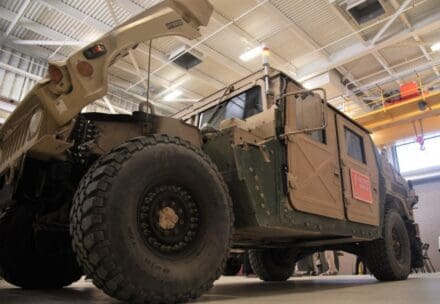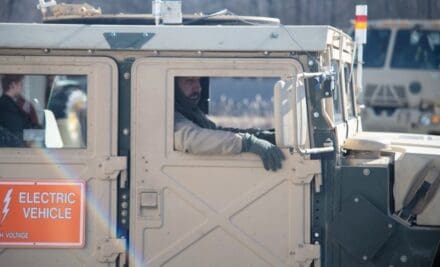
ABERDEEN PROVING GROUND, Md. — In February 2024, the Rapid Capabilities and Critical Technologies Office demonstrated the operational advantages of hybridization to several distinguished guests. The demonstration centered on highlighting the vehicle’s impressive features, which include an extended silent watch, silent mobility, increased on-board power generation and off-board power export.
The RCCTO’s Tactical Hybrid Electric Vehicle program demonstrates the operational effectiveness and automotive performance of standard tactical vehicles while validating the operational benefits of hybridization. Integrating hybrid electric technology will enable the vehicles to operate silently at greater range and more available power for weapon systems and power grids on and off the vehicle. All of these remarkable features provide greater capabilities for our Soldiers.

“The work that the government team and the DoD contractors have completed is a game changer for the Soldiers in the field. We have added silent mobility capability, exportable power, and increased the vehicle range with batteries while reducing heat signature and sound,” said Michael E. Foster, Sr., Director of the Rapid Acquisition Prototyping Project Office within the RCCTO.
“Today’s demonstration underscores the importance of continuing to invest in and develop these technologies. By evaluating innovations, bridging gaps, and collaborating with industry, we strengthen our ability to provide the best tools and resources for our Soldiers, enhancing their safety and capabilities on the frontlines,” said Lt. Gen. Robert A. Rasch, Jr., Director of the Rapid Capabilities and Critical Technologies Office.
The ongoing prototyping efforts for the Stryker and High Mobility Multi-Purpose Wheeled Vehicle continue to give Soldiers the opportunity to validate hybrid electric technologies in operational environments. These vehicles are being tested in real-world military settings to assess their performance and efficiency, ultimately shaping the future of hybrid electric vehicles in military applications.
By Venetia Gonzales


Thought the focus was on motorcycle and bike type vehicles. How would a Stryker charge in the field?
They’re talking about hybrids here, not fully electric vehicles.
I would love to know how these work in a jungle environment. What’s the lifespan look like in a very hot, very humid environment where it constantly rains and we drive through deep water on a constant basis?
Maybe it’s ok……I don’t know.
Likely little different since, again, the article is discussing hybrid vehicles. You know, fossil fuel plus electric.
In my experience of over six years working in multiple jungles in the world, anything electrical-related doesn’t last long. The higher level and complex the technology, the jungle has a way of destroying it. Being not super familiar with hybrid vehicles, will it still work if all the electronic components crap out? i.e. does it just become another gas-run vehicle?
There are several separate but interrelated concerns- added complexity, battery performance and safety, and cost. Not sure what tracks they’re looking at in the design, but the simplest seems to be something along the lines of the Jeep 4xe’s where you have an electric motor inserted into the middle of a traditional drive train. It’s not 100% out of the question for something like that to be either deleted or disconnected as needed, but I don’t know that it’ll be simple IRL as the rest of the components are designed or optimized for that interplay- suspect it’d be underpowered and potentially high wear because of it.
Remember, the US has been using vehicles with batteries for decades. If that humvee’s battery doesn’t work, neither does the truck.
No where near the same complexity,sensitivity, safety, etc. Those two 12v
lead acid batteries are not even remotely the same as thousands of 40 mm LiFePo welded together along bus bars. You aren’t going to jump a EV’ main pack if it’s marginal, it’s likely going to destroy the whole truck trying to run it under voltage.
That’s basically what Toyota did with the 3rd generation Hybrid Tundras.
It’s not terribly efficient (as far as the colloquial standard that people have come to judge hybrids by), but it does successfully provide sufficient power, offsetting the use of a smaller ICE.
In the case of my Tundra, the vehicle can run from either source independently or together, but the computer controls that. I have a feeling that it could run solely off of the ICE if there were a fault within the hybrid system, so the same should be possible with a “Hybrid HMMWV”. It all depends on where the power for the clutch comes from.
Short answer: Yes
Speaking on the very limited basis of current North American civilian passenger hybrid vehicles, me working for a large US based vehicle collision/repair company, the current crop of hybrids are not reliable and doubly difficult to repair. Hope from the above that there is second and third order technology being used. Or maybe the above will only be used in non combat areas.
This is a HORRIBLE idea! However, the idea of updating older vehicles with better drive systems certainly has merit. I just don’t think this is one of them.